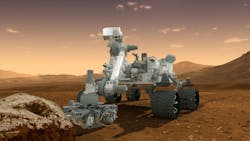Energy Harvesting Lessons from the Mars Curiosity Rover
Thermoelectric devices used on the Curiosity Rover, which recently landed on Mars, are used to generate operating power for the rover derived from the heat created while it moves, allowing the rover to continue working even in the absence of light required by its solar-powered sensors. But these thermoelectric devices are not only being deployed in cutting edge space operations. The U.S. Department of Energy is currently using such sensors in its work with BMW and GM to turn heat waste from engines and exhaust into power for the vehicle's electrical systems.
By converting temperature differences into electrical energy, thermoelectric generators function by leveraging what is known as the Seebeck effect: the conversion of a temperature differential into electricity at the junction of two materials.
A new report from IDTechEx explains that although thermoelectric phenomena have been extensively used for heating and cooling applications, electricity generation has only seen limited use in niche applications and it is only in recent years that interest has increased regarding new applications of energy generation through thermoelectric harvesting. In the report, energy harvesting and related technologies used to power the Mars Curiosity rover are detailed in a way to help industry better understand these markets and the potential applications for them.
Beyond providing assurance that these technologies have progressed beyond trials and new product announcements, the report provides best practice benchmark data and aids in identifying successful suppliers, technologies and users to help industries learn more about energy harvesting devices. The “Analysis of Energy Harvesting Applications” report provides analysis of more 170 successful ongoing uses of energy harvesting in 33 countries.
In 2012, according to the report, most energy harvesting devices use solar cells or electrodynamos. Piezoelectric energy harvesters are also of great interest due to their small form factor and high efficiency. However, many new technologies, such as thermoelectrics, are beginning to take some market share from the more established devices by enabling the generation of power in areas not possible before. In 2022, these four energy harvester types are expected to have near similar market share for industrial sensing applications.
See more Automation World coverage of energy harvesting:
About the Author
David Greenfield, editor in chief
Editor in Chief

Leaders relevant to this article:
